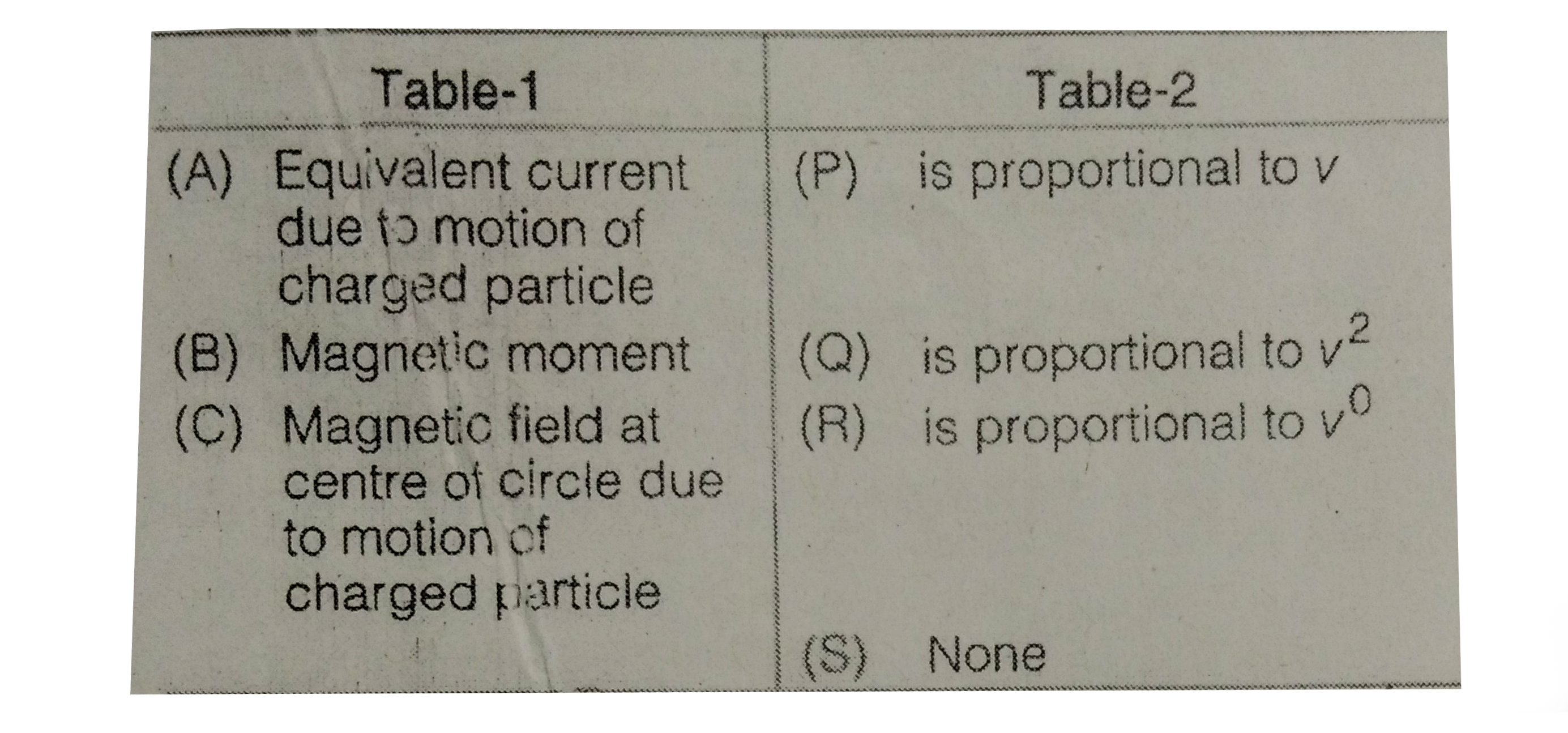A proton of energy 8eV is moving in a circular path in a uniform magnetic field. The energy of an alpha particle moving in the same magnetic field and along the same path will be
(a) 4eV
(b) 22eV
(c) 8eV
(d) 6eV
The correct Answer is:A
To solve the problem, we need to analyze the motion of the proton and the alpha particle in a uniform magnetic field. Here’s a step-by-step breakdown of the solution:
Step 1: Understand the Motion of Charged Particles in a Magnetic Field
When a charged particle moves in a magnetic field, it experiences a magnetic force that acts as a centripetal force, causing it to move in a circular path. The centripetal force Fc can be expressed as:
Fc=mv2r
where m is the mass of the particle, v is its velocity, and r is the radius of the circular path.
Step 2: Relate the Centripetal Force to the Magnetic Force
The magnetic force Fm acting on a charged particle moving with velocity v in a magnetic field B is given by:
Fm=qvB
where q is the charge of the particle.
Step 3: Set the Forces Equal
For a charged particle moving in a circular path, the centripetal force is provided by the magnetic force:
mv2r=qvB
From this, we can derive the expression for the radius r:
r=mvqB
Step 4: Write the Radius for Proton and Alpha Particle
Let’s denote:
- For the proton: mass = m, charge = e, velocity = vp, radius = rp
- For the alpha particle: mass = 4m (since an alpha particle has 2 protons and 2 neutrons), charge = 2e, velocity = vα, radius = rα
Using the radius formula:
rp=mvpeB
rα=4mvα2eB=2mvαeB
Step 5: Set the Radii Equal
Since both particles are moving in the same circular path:
rp=rα
This gives us:
mvpeB=2mvαeB
Cancelling out common terms:
vp=2vα
Step 6: Calculate the Kinetic Energies
The kinetic energy KE of a particle is given by:
KE=12mv2
- For the proton:
KEp=12mv2p
- For the alpha particle:
KEα=12(4m)v2α=2mv2α
Step 7: Substitute vp in Terms of vα
Substituting vp=2vα into the kinetic energy of the proton:
KEp=12m(2vα)2=12m(4v2α)=2mv2α
Step 8: Compare the Kinetic Energies
Now we can compare the kinetic energies:
KEp=2mv2α
KEα=2mv2α
Thus, we find that:
KEp=KEα
Conclusion
Since the kinetic energy of the proton is equal to the kinetic energy of the alpha particle, the energy of the alpha particle moving in the same magnetic field and along the same path is also 8eV.
Final Answer
The energy of the alpha particle is 8 eV.
---
When a charged particle moves in a magnetic field, it experiences a magnetic force that acts as a centripetal force, causing it to move in a circular path. The centripetal force Fc can be expressed as:
Fc=mv2r
where m is the mass of the particle, v is its velocity, and r is the radius of the circular path.
The magnetic force Fm acting on a charged particle moving with velocity v in a magnetic field B is given by:
Fm=qvB
where q is the charge of the particle.
For a charged particle moving in a circular path, the centripetal force is provided by the magnetic force:
mv2r=qvB
From this, we can derive the expression for the radius r:
r=mvqB
Let’s denote:
- For the proton: mass = m, charge = e, velocity = vp, radius = rp
- For the alpha particle: mass = 4m (since an alpha particle has 2 protons and 2 neutrons), charge = 2e, velocity = vα, radius = rα
rp=mvpeB
rα=4mvα2eB=2mvαeB
Since both particles are moving in the same circular path:
rp=rα
This gives us:
mvpeB=2mvαeB
Cancelling out common terms:
vp=2vα
The kinetic energy KE of a particle is given by:
KE=12mv2
- For the proton:
KEp=12mv2p
- For the alpha particle:
KEα=12(4m)v2α=2mv2α
Substituting vp=2vα into the kinetic energy of the proton:
KEp=12m(2vα)2=12m(4v2α)=2mv2α
Now we can compare the kinetic energies:
KEp=2mv2α
KEα=2mv2α
Thus, we find that:
KEp=KEα
Since the kinetic energy of the proton is equal to the kinetic energy of the alpha particle, the energy of the alpha particle moving in the same magnetic field and along the same path is also 8eV.
The energy of the alpha particle is 8 eV.
Topper's Solved these Questions
- MAGNETIC FIELD AND FORCESBOOK - DC PANDEY ENGLISHCHAPTER - MAGNETIC FIELD AND FORCESEXERCISE - Taking it together
75 Videos
- MAGNETIC FIELD AND FORCESBOOK - DC PANDEY ENGLISHCHAPTER - MAGNETIC FIELD AND FORCESEXERCISE - Assertion and reason
20 Videos
- MAGNETIC FIELD AND FORCESBOOK - DC PANDEY ENGLISHCHAPTER - MAGNETIC FIELD AND FORCESEXERCISE - Medical entrance s gallery
59 Videos
- INTERFERENCE AND DIFFRACTION OF LIGHTBOOK - DC PANDEY ENGLISHCHAPTER - INTERFERENCE AND DIFFRACTION OF LIGHTEXERCISE - Level 2 Subjective
5 Videos
- MAGNETICSBOOK - DC PANDEY ENGLISHCHAPTER - MAGNETICSEXERCISE - MCQ_TYPE
1 Video
Similar Questions
Knowledge Check
A charged particle is moving on circular path with velocityv in a uniform magnetic field B, if the velocity of the charged particle is doubled and strength of magnetic field is halved, then radius becomes
A8 timesB4 timesC2 timesD16 times
A proton carrying 1MeV kinetic energy is moving in a circular path of radius R in uniform magnetic field. What should be the energy of an α− particle to describe a circle of the same radius in the same field?
View SolutionThe path of a charged particle moving in a uniform steady magnetic field cannot be a
View SolutionA proton carrying 1MeV kinetic energy is moving in a circular path of radius R in unifrom magentic field. What should be the energy of an α− particle to describe a circle of the same radius in the same field?
View SolutionA charged particle moves in a uniform magnetic field. The velocity of the particle at some instant makes an acute angle with the magnetic field. The path of the particle will be
View SolutionAssertion A charged particle is rotating in a circular path in uniform magnetic field. Then, plane of circle is perpendicular to the magnetic field.
Reason Circular motion is a two-dimensional motion.
View SolutionParticles 1, 2 and 3 are moving perpendicular to a uniform magnetic field, then particle

View SolutionA charged particle moves in a circular path in a uniform magnetic field. If its speed is reduced, then its tiem period will
View Solution
